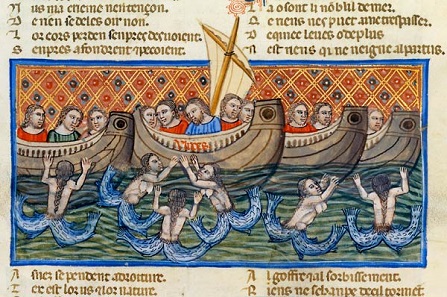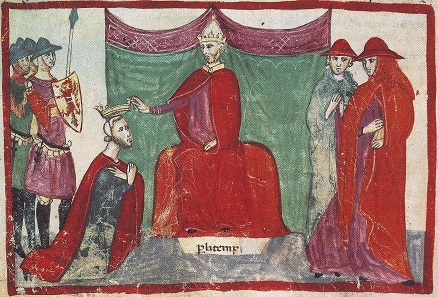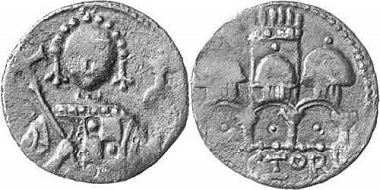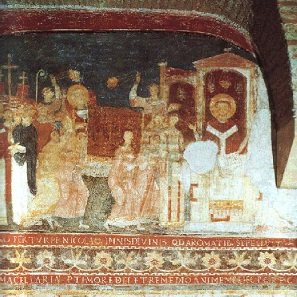translated by Katja Protsiva
The three Norman brothers Wilhelm, Drogo and Humfried of Hauteville knew how to use the weakness of the Byzantine Empire in the south of Italy for their purposes. Not only did the eldest brother, Wilhelm, get his sobriquet Iron Arm during those fights but he also won a leading position among the Normans. But a life ends quickly if one has to expect a fight every day. Wilhelm died only eight years after his arrival in Apulia. However, he already had such a great power at that time that the German emperor took care of his legacy himself and approved Drogo, the second brother, as the new owner of the Apulian possessions.
The torn Odysseus resists the singing of the Sirens. Miniature from the novel about Troy written by Benoît de Sainte Maure, between 1340 and 1350. Source: Wikielwikingo / CC BY 3.0
Robert Guiscard
Approximately at that time, Robert of Hauteville came to Apulia – if we want to believe Anna Komnena – with just five knights and thirty foot soldiers. Robert was the eldest of the seven sons that Tancred had with his second wife. The chroniclers describe him as tall and blond. They saw him as a born leader due to his broad shoulders, his sturdy body and his loud voice. But that alone would have not helped him enough. It was Robert’s formidable intellect that distinguished him from his contemporaries. He got his sobriquet “Guiscard“, the Cunning, due to his wily ideas that lead his contemporaries to compare him to Odysseus.
For example, there is a story about how Robert conquered the Malvito fortress. It was invulnerable because it was located in steep altitude. According to the chroniclers, Robert sent a message to the monks of a monastery within the fortress that he would like to bury one of his followers in their church. The abbot did not want to deny this godly request but he ordered strict supervision to make sure that the mourners did not bring weapons inside the fortress. So they entered the church. Just when the coffin was lowered into the grave, a pretty lively Norman jumped out of it and quickly distributed the swords hidden inside the coffin among his comrades. The blindsided crew surrendered and Robert had conquered the fortress. The story is so beautiful that it does not actually matter that it is probably not true. There is also the exact same story featuring other protagonists. Most likely, it is a legend simply used to picture that Robert Guiscard was able to think in such ruthless and unconventional ways.
The Scribla fortress, a moth on an artificial hill, was very modest in the days of Robert Guiscard. Photo: Daniel Boos / CC BY-SA 3.0
When Robert arrived in Lower Italy, he obviously wanted to use his brothers’ success as a stepping stone for his own advancement. He finally talked the older Drogo into leaving him the small fortress of Scribla at the northern border to Calabria. It was an excellent starting point for plundering which Robert pretty comfortably lived on. His new prosperity attracted further knights and convinced an already established Norman to let him marry his daughter. She brought about 200 knights into the marriage who made plundering possible in a completely new way.
Battle of Civitate
By that time, Humfried, the third brother of the house of Hauteville, lead the Normans because Drogo had died in a battle against some rebellious Apulians – as mentioned before, most Norman adventurers were given a rather short life. Humfried took command of the army that faced the combined troops of the Byzantine and the German emperor who tried to clear the Norman disturbers out of Southern Italy on the initiative of Pope Leo IX.
The defining battle took place in 1053 near Civitate. It turned the fate of Lower Italy. The old powers had to realize that they could not get rid of the Normans that easily anymore. And the Normans realized that they had enough forces to turn entire Lower Italy into a Norman empire.
In this memorable battle, Robert already commanded a third of the Norman forces. So in those nearly seven years he had been in the country, he managed to become one of the most powerful rulers. That way, he could undisputedly inherit Humfried’s heritage when he died in 1057. And here the story repeats: Approximately at the same time, Robert’s younger brother Roger arrived and obviously wanted to have his own fortress right away. But the older brother could still very well remember his own arrival. He was too smart to pave the way for his potential competitor. He tried to make Roger work for him which he naturally did not like at all.
Robert Guiscard is crowned duke by Pope Nicholas II. Depiction from the Nuova Cronica of Giovanni Villani, 14th century.
Church policy part 1
1059 was the defining year for Robert. That year, Pope Nicholas II took a surprising decision. Instead of operating against the Normans any longer, he invested Robert as legitimate duke of Apulia, Calabria and the Muslim Sicily. With that, he disregarded the rights of the former rulers and used his clerical power to justify the Norman aggressors’ deprivation. Why would a pope do such a thing?
Robert Guiscard. Doppio Follaro. Rv. Fortress of Salerno, in section VICTORI-A. From auction Gorny & Mosch 123 (2003), no. 3761.
In order to understand that, one has to take a closer look at the church history. That is to say, Nicholas II himself had come to power through a blatant breach of law. However, the reformed church justified it with such a tremendous propagandistic effort that the world has forgotten in the meantime that the cardinals only gained the privilege of electing the pope in 1058. Before that, this right was reserved for the urban Roman aristocracy and the German emperor.
The remains of the once world’s largest church, Cluny. This was not only where the church reform started but also where the fight between earthly and clerical power began. Photo: Jan Sokol / CC BY-SA 3.0
When Heinrich III died and his successor was too busy to take an interest in the election of the pope, the cardinals used the opportunity and preempted the urban Roman aristocracy with the pope’s election. Unfortunately, the candidate of the reformed church died relatively soon. Therefore, the urban Roman aristocracy took the initiative and elected the next pope. So far, that was legally correct. But the reformed clergy created a new law. In 1058, they elected an antipope – namely Nicholas II, obviously. Of course, he had, as one can easily imagine, a certain problem of legitimacy. He looked for support and found it with the Normans.
Pope Nicholas II in a fresco in the Roman Abbey of San Clemente a Casauria.
Church policy part 2
After all, there was a schism between the Catholic Church and the Byzantine Empire since 1054, from whom the Normans had taken away the disputed territory. The Roman bishop, the pope, claimed to be the head of the whole church – while knowing exactly that his power ended a few kilometers south of Rome. In the formerly Byzantine realm, an orthodox clergy was in charge of the salvation of its fosterlings. However, the Normans were not orthodox but well catholic. Therefore, they qualified perfectly for bringing formerly orthodox territories under the clerical control of the pope. That was one part of the asset Nicholas II got for his breach of law. The other part was the Norman oath of fealty by Robert Guiscard, stating that after his death he would ensure a duly – that is, held in accordance with the reformed church – election of the pope by the cardinals.
This agreement must have been slightly scary for Robert Guiscard. Anyhow, he did not merely rely on the pope’s power. When the last town of Calabria, Reggio, fell into his hands in 1060, he followed the Norman tradition and got himself again invested as duke by his own men.
In the next chapter, you can read how the ambitious Robert Guiscard expanded his power – and therefore came into conflict with his papal benefactor.
Here, you find all the chapters of the series.
And if you want to see more pictures of Sicily, we recommend you our series „Sicily in full bloom“.











